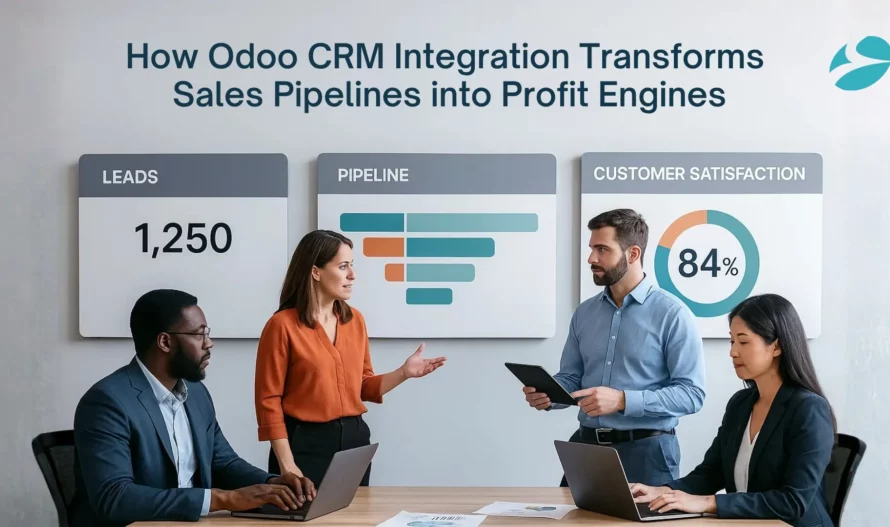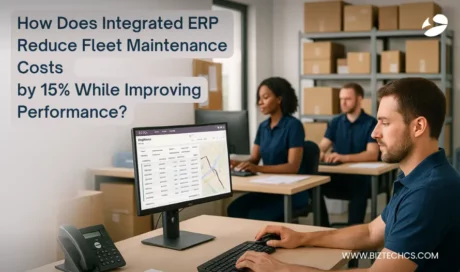361
How Odoo CRM Integration Transforms Sales Pipelines into Profit Engines?
10 Oct, 2025
5 min read
361
10 Oct, 2025
5 min read

In today’s connected economy, customer relationships are not built in spreadsheets — they’re shaped by data, timing, and insight. Yet, across growing companies, sales and service teams still struggle with disconnected tools, duplicate records, and missed follow-ups.
The problem isn’t a lack of tools — it’s that none of them talk to each other. And that’s precisely where Odoo CRM Integration becomes truly transformative. It’s not just a plug-in or add-on solution. It’s a strategic bridge that aligns marketing, sales, inventory, finance, and support into one dynamic ecosystem.
I’ve watched mid-sized and enterprise clients replace their fragmented SaaS tools with a unified Odoo CRM core — and the shift isn’t just about capturing more leads. It’s about driving real, measurable sales acceleration and building the kind of customer loyalty that actually drives results.
Odoo CRM Integration isn’t just a technology upgrade but an operational mindset shift. It helps to collect data from various sources, like Google Sheets, WhatsApp messages, and outdated Excel trackers. This will help the organization consolidate data from various sales touchpoints into a single CRM platform.
This will bring visibility not only to who is buying but also why they are buying. Sales reps can finally track the lead from its origin to follow-up history in a single space. Though it is always advised to define the sales-to-fulfillment workflow. This is because once lead stages are aligned with your regional process (especially in GCC VAT environments), integration with inventory and invoicing becomes seamless.
Odoo integration improves the lead conversion rate by nearly 38% and accelerates quotation turnaround by 45%.
In the world of B2B commerce, delayed data equals delayed revenue. Sales teams operating on stale information can’t pivot to market realities.
That’s why Odoo CRM Integration enables real-time dashboards across lead pipelines, team performance, and revenue forecasts. For instance, a Saudi-based retail group we worked with used to close monthly reports manually, 10 days after the due date. After Odoo integration, automated reporting and predictive analytics cut that delay to under 2 hours.
For instance, consider a retail group that previously handled monthly sales reports manually. Month-long records couldn’t be done in a day; it would take at least 5 to 7 days, which meant delayed information accessibility.
Delay in accessing information further slows down the decision-making process. But with Odoo’s automated reporting and predictive analytics, this process can be reduced from days to a few hours. The system dynamically links sales data to stock levels and logistics updates, allowing everyone to stay informed and make informed decisions.
Sales forecasting isn’t about predicting the future; it’s about eliminating uncertainty. When Odoo CRM syncs with accounting, purchase, and inventory modules, leadership can see exactly what’s selling, what’s stalling, and where to allocate resources. This replaces chances and possibilities with data-driven, definitive decisions.
How Odoo configures these dashboards for different roles:
A CRM is indeed only as powerful as the insights it produces. Odoo CRM integration enables customer profiles to evolve in real-time as new quotes, calls, and purchases are added to the relationship history.
For instance, a B2B manufacturer can use Odoo CRM to integrate marketing automation and WhatsApp connectors. This will allow their sales reps to trigger automated follow-ups when a quotation remains unopened for a set duration of time (like, let’s say, 48 hours). This is not a major automation, but it can increase the response rates by 33%.
Many manufacturers ask, “Can Odoo CRM tell me which customers are most likely to buy in a particular week?”
Well, the answer to this question is yes. Odoo’s built-in scoring mechanism ranks leads based on engagement, purchase frequency, and region. By tying this to localized pricing logic, your sales teams can transition from reactive to predictive selling, leveraging data-driven insights.
The most significant advantage of Odoo CRM Integration isn’t just within the sales department — it’s the collaboration it fosters across departments.
Many large-scale distributors struggle with order misalignment. Sales would promise timelines that procurement couldn’t meet, and finance received incomplete invoices. Odoo implementation services can change that dynamic.
Businesses can align CRM → Inventory → Accounting → Delivery through automated triggers. When a quotation turns into a sales order, procurement is notified instantly. Upon delivery completion, the finance department will receive auto-generated invoices pre-tagged with required compliant digital signatures.
This cross-functional clarity will save hours of reconciliation per week and eliminate “blame loops” between departments.
Odoo Consultant Tip: Staging your rollout into four key phases is advised here. So, divide the entire integration process into separate processes or departments (such as CRM & Leads, Sales & Quotations, Inventory & Invoicing, and Customer Support). This ensures that every department adapts progressively, with clear ownership, measurable KPIs, and minimal disruption.
Efficiency is not just about how you treat your existing customers; it is also defined by how you interact with the new leads. And, customer satisfaction thrives on speed and consistency. Whether in retail or B2B manufacturing, delayed responses kill momentum.
With Odoo CRM Integration, every customer action, from website form submissions to email inquiries, is automated. When paired with Odoo Helpdesk or Live Chat, businesses can close the loop faster. In fact, using Odoo’s automation to assign tickets based on product type and language can reduce the response time by over 50%.
One thing that comes to everyone’s mind during process automation is whether this automated system will replace the human process entirely. The answer to this question is no; automation cannot replace human interaction and intelligence, but rather enhances it.
When repetitive tasks, such as lead tagging and quote generation, are automated, sales reps have more time to engage with clients for negotiation and understanding of their requirements.
A standalone CRM can only go so far. But with Odoo CRM Integration, every department speaks the same language.
When marketing launches a campaign, leads are automatically imported into the CRM; when inventory levels are low, the sales module updates accordingly. Finance receives revenue insights in real time — closing the feedback loop.
For example, an eCommerce business, CRM-to-Marketing automation can push abandoned cart data into follow-up email sequences — recovering a massive chunk of capital stuck in lost sales in just six weeks.
Meanwhile, Odoo’s finance module ensured VAT compliance for both the UK and UAE entities, providing accurate, dual-currency invoicing.
Today, in a world where efficiency is the primary driving force for a recurring client base, customer experience has become the new battleground for growth. Efficient operations result in streamlined processes for customers.
Odoo CRM Integration turns every interaction into insight. With customer data centralized, you can personalize campaigns, recommend products, and identify churn risks early. The current scenario showcases that data is not the new oil, but context is.
For instance, a healthcare facility can use automate patient onboarding from emails to follow-ups. The contextual understanding will enable the system to schedule follow-ups, automate digital check-ins, and provide personalized advice. This can completely transform administrative processes, thereby positively impacting patient satisfaction and overall experience.
In markets like Saudi Arabia and the UAE, sales happen on the go — in warehouses, trade shows, and client offices. Odoo CRM Integration ensures that your team doesn’t need to “check back at the office” to close deals.
Through mobile CRM access, field representatives can view leads, send quotes, and record interactions in real-time. Odoo CRM’s geolocation tracking lets managers view who is closing the deals faster in every region and scenario without actually going there.
Offline CRM access on mobile devices helps stay connected in areas with patchy connectivity. Odoo automatically syncs once the device reconnects, which prevents data loss. Result? 27% higher deal closure rate and complete transparency across mobile sales activity.
One of the overlooked benefits of Odoo CRM Integration is its built-in compliance flexibility. Whether you’re managing UAE VAT, KSA ZATCA e-invoicing, or India GST — your CRM aligns with regional accounting rules.
BiztechCS tailors every rollout to local compliance frameworks through its expert Odoo development services. In Saudi Arabia, for example, our CRM workflows include e-invoicing triggers and Arabic language support. In the UAE, we align lead sources and quotations with VAT journal entries to maintain reporting accuracy.
This localization-first strategy ensures businesses don’t just go live fast — they stay compliant sustainably. We often remind our clients that compliance is a mindset, and integrating it into your CRM ensures accountability and security across every sale.
The ROI of Odoo CRM Integration
Odoo CRM Integration consistently delivers tangible ROI. Across multiple businesses, their operations and processes, here’s what Odoo implementation can do as per our observation:
That’s the compounding power of integration: speed, visibility, and confidence.
The future of business growth isn’t about more leads, but it’s about smarter relationships. With Odoo CRM Integration, companies can align every touchpoint — from marketing to accounting — into one intelligent system. It’s not just CRM; it’s the backbone of connected commerce.
At BiztechCS, we specialize in designing these ecosystems for real-world impact — balancing technology precision with regional nuance. Whether you’re scaling across the GCC, Europe, or North America, our Odoo consultants ensure your CRM becomes your sales intelligence hub — not just a contact list.
Let’s map your integration roadmap — one module, one milestone at a time.

Odoo
29
By Uttam Jain
26 Nov, 2025

Artificial Intelligence (AI)
49
By Afzal Qureshi
26 Nov, 2025

Artificial Intelligence (AI)
82
By Afzal Qureshi
25 Nov, 2025